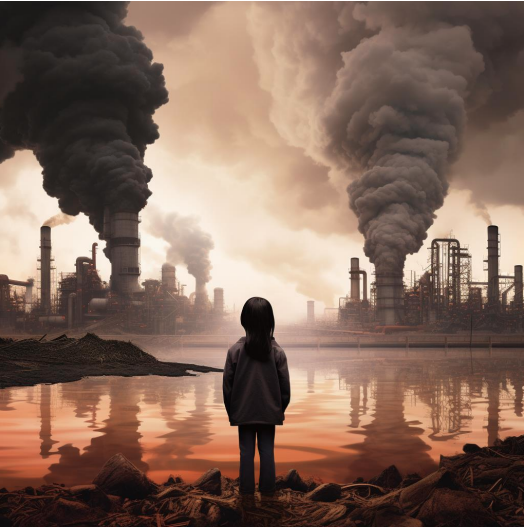Have you ever wondered why we are so avoidant when it comes to discussing climate change in our daily lives? With our friends, families and generally our daily lives there is a deadly silence when it comes to a crisis that we are all facing today, regardless of our race, gender, nationality, class, etc.! We dedicate all our lives somehow or the other to either #survive, #thrive or both but when it comes to an #existential crisis that science is so sure about, we remain silent! Hmmm… we are interesting beings for sure! For many of us this is not because we don’t care about ourselves, our children and or the world we leave for them, I mean it doesn’t make sense from an evolutionary perspective. Also, it’s probably not because we don’t know about it cause as a “#modern” human being we are so obsessed with science that we can’t just typically say: We don’t care/believe in what science and scientists have been shouting! So, what is it really? What holds us back? Probably there are many aspects to it, but let’s dig deeper in one that comes to my mind!
One reason is the complexity of the climate change discourse. We’re bombarded with complex charts and #statistics that create a gap between the data and our daily experiences. It’s as if we’re speaking different languages, and this gap can leave us feeling disconnected and helpless. We fear that bringing up climate change will overwhelm others or dampen the mood in casual conversations. But here’s a way to bridge that gap: let’s talk about the human cost of climate change, something we can all understand – the real stories of people facing the consequences. Imagine children inhaling air thick with #wildfire smoke or communities being swallowed by #floods and #flames. Think about the pain of lives cut short, entire habitats disappearing, and countless plants and animals under threat. The true cost of climate change can’t be measured in dollars and cents. It’s about people finding themselves in unrecognizable places as our world becomes more unpredictable. And here’s the harsh reality: the burden falls heaviest on those least equipped to cope. Natural disasters and climate change hit hardest in communities already struggling to make ends meet. These #communities often rely on ecosystems that are under threat, making their lives even more precarious.
Migration
Here’s a scenario that sends shivers down your spine: Right now, just 1% of our planet is grappling with #unbearable heat, making it almost #unlivable. But hold on to your seat because, by the year 2070, that nightmarish sliver could balloon to a staggering 19%.
Now, let’s bring it home: billions of people, living their everyday lives in these areas, suddenly find themselves in a gripping dilemma. The question haunting them is as ordinary as it is terrifying: Where, in the midst of this unfolding suspense, will they go?
Meet Sarah, a member of the Torres Strait Islander Community, whose life revolves around the picturesque islands nestled between Australia’s northern tip and Papua New Guinea.
These islands have been her home, her sanctuary, and the keeper of her ancestors’ stories. But the changing climate has cast a shadow over her beloved islands. Rising sea levels, driven by climate change, have eroded the coastline, causing houses to teeter at the edge of the ocean. More frequent and ferocious #cyclones and #storms have torn apart homes, making everyday life increasingly challenging.
Sarah’s family, like many others, has traditionally relied on #fishing and #farming, but the shifting ocean currents and erratic weather patterns have made it harder to catch fish and grow crops. As the challenges mount, some families face a heartbreaking decision – whether to stay and face the growing risks or to migrate to the Australian mainland in search of safety and opportunities.
For Sarah’s community, it’s not just about physical #displacement; it’s also about the loss of #cultural #identity and traditions deeply tied to the land and sea. Despite the challenges, the community has shown remarkable resilience, coming together to adapt and preserve their way of life as best they can.
Health
Climate change isn’t just about rising temperatures; it’s a hidden health crisis. A recent report by health experts worldwide reveals alarming trends: increasing #heat-related illnesses, easier spread of #diseases, disrupted sleep patterns, and a troubling rise in suicides. These real-life consequences affect us, our families, and our #communities deeply.
In cities around the world, including New York City in the United States, extreme heat events are occurring with greater frequency and severity. These heatwaves can lead to a surge in heat-related illnesses such as heat exhaustion and heatstroke, particularly among the #elderly, children, and those with pre-existing health conditions.
During a particularly scorching summer, the city of New York experienced a prolonged heatwave with temperatures soaring well above 100°F (37.8°C). Hospitals were inundated with patients suffering from heat-related ailments, including #dehydration, heat exhaustion, and life-threatening heatstroke.
Emergency rooms and medical facilities were stretched to their limits as doctors and nurses worked tirelessly to provide care. Tragically, there were cases of individuals, especially the elderly and those without access to air conditioning, succumbing to the #extreme #heat.
This example underscores the direct link between climate change-induced heatwaves and public health. Climate change is making such extreme heat events more common and severe, posing serious health risks to communities and highlighting the urgent need for climate action to protect public health.
Education
Meet Carlos, a young student living in Puerto Rico, a beautiful island in the Caribbean. Carlos loved going to school and learning new things. But one day, everything changed.
In 2017, #Hurricane #Maria swept through Puerto Rico, leaving a path of destruction in its wake. Carlo’s school was no exception. The powerful storm damaged the building, making it unsafe for students and teachers. Carlos’s school, like many others on the island, had to close its doors.
For Carlos and his classmates, this meant not being able to go to school for a long time. They missed their teachers, friends, and the routines they were used to. It was a tough time for everyone.
But that wasn’t the only challenge. Many families, including Carlos’s, had to leave their homes because they were damaged or destroyed by the #hurricane. Carlos found himself in a new place, with a new school and new classmates. It was a big adjustment, and he felt a bit lost.
The hurricane also took a toll on Carlos’s #mental #health. The stress and uncertainty of the situation made it hard for him to concentrate on his studies. He often worried about his family and their future.
Even when Carlos did go to school, there were challenges. The hurricane had damaged the island’s infrastructure, causing power outages and water shortages. Some days, there was no electricity to light up the classrooms, and the heat made it hard to focus. It was tough for both students and teachers.
As time passed, Carlos realized that he and his classmates were falling behind in their studies. The delays in their curriculum meant they had to work extra hard to catch up. Carlos worried about what this might mean for their future #opportunities.
Water
Meet Lisa, a resident of Cape Town, South Africa, where urban life bustles against the backdrop of the stunning Table Mountain. For years, Lisa’s city had been thriving, but then something unexpected happened – the water began to run out.
It all started with changes in the weather. The rains that #CapeTown relied on for its water supply became less predictable and reliable, a consequence of shifting #rainfall patterns brought on by climate change. It didn’t take long for Cape Town to feel the strain.
As the city grew, so did its thirst for water. Urbanization brought more people, more homes, and more demand for water. Lisa watched as the population swelled, and water became scarcer.
Soon, a daunting phrase entered everyone’s vocabulary – “Day Zero.” It was the day when the municipal taps would run #dry, a grim reality that Cape Town was hurtling toward. Lisa couldn’t help but feel a knot of anxiety in her stomach as she wondered what life would be like without a reliable water source.
#Vulnerable communities within Cape Town felt the crisis most acutely. In informal settlements, access to water was already a daily struggle, and the crisis exacerbated their hardships. Long lines formed at water distribution points, where people queued for hours to collect their daily ration.
The crisis rippled through every aspect of life. Businesses struggled, tourism dwindled, and job opportunities dried up. Lisa saw firsthand how the crisis disproportionately affected marginalized urban populations, exposing deep social disparities in #water access.
Food
Let’s step into the life of Raj, a #farmer in rural #India. For generations, his family has depended on the #monsoon rains to nourish their crops and provide for their livelihoods. But in recent years, something has changed – the monsoons have become increasingly unpredictable.
As Raj tills his fields, he can’t help but worry. The rains used to arrive like clockwork, ensuring a bountiful #harvest. But now, they come late, or sometimes not at all. Climate change has brought about erratic and extreme rainfall patterns, leaving Raj and his fellow farmers guessing when the next drop will fall.
One year, a prolonged #drought struck his region. The soil cracked, and the crops withered away. Raj’s family struggled to make ends meet, and many others in the village faced the same plight. The uncertainty of the changing climate was taking a toll on their lives.
Conversely, in another season, unrelenting rains caused severe #flooding. Raj’s fields were submerged, washing away his hard work and hopes for a good harvest. It felt like a cruel twist of fate, and the losses were devastating.
The impact extended beyond the farms. With crop failures and soaring food prices, Raj’s family, like many others, had to tighten their belts and skip meals. Nutritious food became a luxury, and the threat of #hunger loomed large.
For some in the village, the challenges became insurmountable. Unable to provide for their families, they were forced to leave their ancestral homes in search of #opportunities in overcrowded cities, adding to the urbanization challenges in India.
The escalating costs and human suffering caused by climate change, along with our continued reliance on fossil fuels, underscore that inaction is not an option – it’s the costliest and most harmful path we can choose. Strategic investments in #CleanEnergy and climate resilience, with a commitment to equity, offer a way to mitigate the devastating consequences of unchecked climate change while fostering a fairer and healthier society. Can we summon the #compassion to do better for the younger generation, whose futures hang in the balance? Can we protect our planet and its precious biodiversity from the looming threats? Or will we resign ourselves to witnessing an ever-expanding list of catastrophic climate-driven disasters each passing year? As the human toll of climate change disproportionately affects vulnerable nations, it’s imperative that developed countries take bold mitigation actions in the name of #ClimateJustice.

